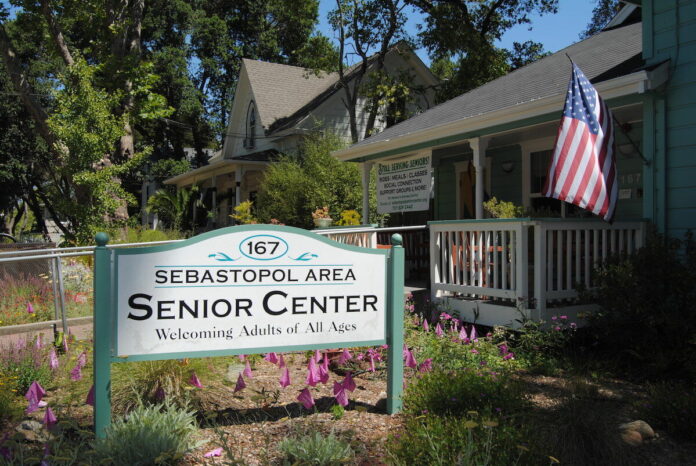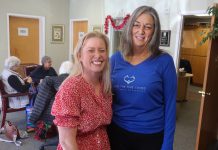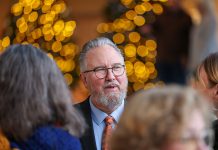
After a year of caring for the community made most vulnerable by the pandemic, the Sebastopol Area Senior Center is reopening with a renewed mission: “helping seniors age in their own homes.”
While the spreading coronavirus forced Sonoma County’s senior communities into anxious isolation, the switch to virtual programming opened new doors for the center, according to Executive Director Katie Davis. Operating entirely on Zoom, they brought yoga classes, lecture series, daily meals and even trips to Europe directly into senior homes.
As the center begins to resume in-person operations, many of the changes and lessons of the pandemic year will remain in place.
Last March, as the risks that coronavirus posed to people above 65 became more apparent, the center closed its doors three days before the county enacted its own shelter-in-place order. By April 1, most the center’s class offerings had pivoted to Zoom and remained entirely virtual until this month.
Transitioning the center’s in-person offerings to the virtual world expanded its demographic reach, according to Davis. With physical access barriers removed, popular Zoom-based exercise and balance classes began to draw customers from as far as Maryland and Idaho.
According to Davis, the center’s diverse class offerings all center social connection, which became crucial during the pandemic. “Our instructors are highly trained, they’re personable and they know that it’s more than just, they’re there to teach a class — they’re there to interact, to talk to each other,” she said. “They’re meeting friends in the Zoom rooms.”
Pre-pandemic, one of the center’s most popular offerings was its day trips around the Bay Area. As shelter in place brought this program to a halt, day trips went virtual as well, this time, to Pompeii and Paris instead of San Francisco.
While in-person day trips had a rough cap of 40 people, virtual excursions to the Egyptian Pyramids would draw numbers in the sixties and seventies, according to Davis.
COVID also brought major changes to the center’s popular daily lunch program. Before the pandemic set in, local customers would gather in the center’s dining room for meals provided by the county-run Council on Aging. By May of 2020, the in-person lunches had been replaced with a home meal delivery service — a vital resource for people who may not have been able to safely grocery shop at the time.
Davis said the center’s meal delivery service, a continuation of their partnership with the Council on Aging, served an average of 800 meals per week to nearly 120 members of the west county senior community in the last year. While initially targeted at the center’s regular patrons, the delivery service gradually began to spread via word of mouth, until families across the country were calling the center asking if their elderly family members could receive food deliveries.
The delivery service also doubled as a vital outlet for social contact.
“Phone calls and Zoom calls only go so far,” Davis said. “You know, it was the food that we were delivering, but also the fact that a volunteer was actually showing up to their house. We got so many calls saying, ‘that’s the only person we see all week.’”
As regulations have begun to lift at a state level, the center has gradually begun to bring back in-person operations starting last week, beginning with haircuts and Tai Chi classes. Davis said the center plans to roll back its mask mandate soon and reinstitute coffee and tea services along with the popular community puzzle.
Even as the center once again becomes a social nucleus for west county’s senior population, Davis isn’t yet ready to halt many of the new programs instituted during the pandemic. As the center begins its strategic planning process, she said future plans would be closely shaped by the experience of operating through COVID.
“If we stop doing Zoom, if we stop doing meal delivery, I mean, between those two, we’ve served over 1,000 seniors just this last year,” she said. “That would be a huge loss for them, and for us.”
According to Gov. Gavin Newsom’s recently released four-year Master Plan for Aging, the state’s aging demographic is predicted to double in the next decade. By 2030, according to the plan, older adults will comprise ¼ of California’s entire population.
“So for us, we started to think strategically, how do we position ourselves as a vital community resource to make sure that we can serve this growing population?” Davis said, regarding the impending demographic shift. “So it’s opened up a lot of conversation for us that I don’t think would have been there without COVID.”
In April, as the center gradually prepared to open their doors again, they surveyed about 350 community members to see what programs and services they had most missed in the last year. According to Davis, over 90% of respondents mentioned how much they missed the simple social connection that the center facilitates.
“Just these last four days, people are poking their heads and saying, ‘Oh my gosh, I can’t believe I’m able to walk back in here now,’” Davis said. “Tears have been shed, and people are hugging each other again.”








